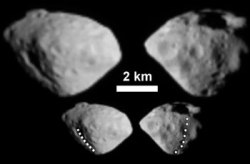Jan 29 2010
When viewed through a telescope, the Steins planetoid is an inconspicuous spot of light. Viewed in more detail, it shows itself to be a kind of debris heap with a diamond-like shape and large craters on its surface. A team headed by Horst Uwe Keller from the Max Planck Institute for Solar System Research in Katlenburg-Lindau has taken a closer look. The scientists used the OSIRIS camera system aboard the European space probe Rosetta for this task. (Science, January 8, 2010).
 A diamond-like flying heap of debris: Images of the Steins asteroid, taken by the OSIRIS camera system aboard the Rosetta space probe
A diamond-like flying heap of debris: Images of the Steins asteroid, taken by the OSIRIS camera system aboard the Rosetta space probe
The images reveal that Steins is not a large chunk of rock, but more an accumulation of many small individual fragments, similar to a heap of debris. This would also explain its conical, diamond-like shape, which was apparently formed through YORP. This is the abbreviation for the Yarkovsky-O'Keefe-Radzievskii-Paddack effect and describes the effect of solar radiation on a small celestial body such as a planetoid. The sun heats up its surface; if the heat is re-emitted as radiation, a small angular momentum results. The rotational speed can thus slow down or increase; the spatial position of the axis of rotation can change - and ultimately the shape of the planetoid as well.
"The detailed analysis of our images indicates that the YORP effect can also play a crucial role for asteroids in the main belt. Something that wasn't clear until now," says Horst Uwe Keller from the Max Planck Institute for Solar System Research, who headed the development and construction of the OSIRIS camera.
The European space probe Rosetta flew past the Steins asteroid on September 5, 2008 at a distance of a mere 800 kilometres. The speed at this fleeting rendezvous was 30,000 kilometres per hour. Steins is an object measuring some 5.3 kilometres in the asteroid belt between the orbits of Mars and Jupiter, where more than 400,000 of these celestial bodies are to be found. It is one of the rare E-type asteroids whose surfaces consist of the mineral enstatite and which has a high reflective power (albedo), meaning they are relatively bright.